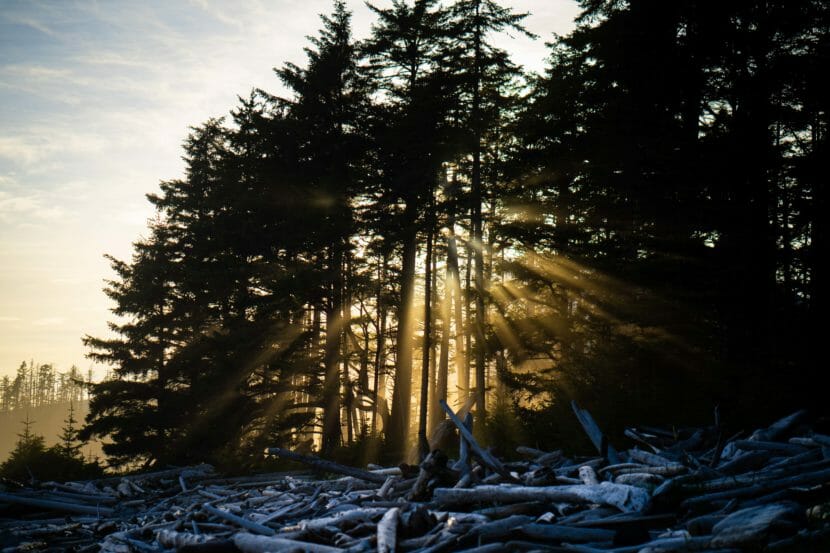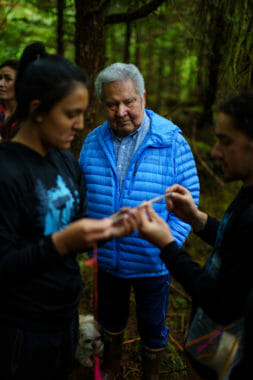
Allison Mills manually drilled a bit into the base of a massive yellow cedar tree on Prince of Wales Island, in Southeast Alaska. The drizzly August day filled with the dull squeak of metal rubbing against wood. Once she reached the center of the tree, she gently pulled the delicate core sample free, lifted it to her face and inhaled the wood’s slightly spicy, medicinal scent. “I love the smell so much,” she said.
Mills, 16, is Lingít and Haida, and had enthusiastically volunteered for the task. She is part of the Prince of Wales Island chapter of the Alaskan Youth Stewards, or AYS, a collaborative program that provides job experience, teaches leadership skills and gives rural youth a chance to support their communities and cultures. For 10 weeks this summer, her crew worked on natural resource and cultural stewardship projects serving their community. The session culminated in a four-day camping trip in a remote forested area, where the crew members searched for trees that might someday be transformed into totem poles or dugout canoes. The search — and the program itself — are part of a regionwide revitalization of carving and other cultural wood practices.


The crew was exploring the Tongass National Forest, the largest national forest in the United States and the largest intact temperate rainforest in the world. At 16.7 million acres, it stretches across more than a thousand islands and encompasses 32 communities in Southeast Alaska. The forest sequesters carbon, provides drinking water and hydropower for thousands of people, and supports large fish and wildlife populations. It’s the foundation for sustenance, culture and a way of life for the Lingít, Haida and Tsimshian, who have lived in the region for millennia.


Over the last several centuries, Russians, Europeans and Americans colonized the region, and between 1902 and 1909, the U.S. government established the national forest on Lingít, Haida and Tsimshian homelands. The logging industry boomed a few decades later, with the first large-scale mills built in the 1950s. Global, state and national interest in Southeast Alaska’s timber intensified, peaking in the 1990s, when thousands of loggers clear-cut about 800,000 acres of productive old-growth forest, according to a 2013 study in the journal Conservation Biology, taking out a quarter to half of the region’s stands of large old-growth trees.. Clear-cutting remains a threat, since federal management of the national forest changes with each administration. Tribal nations and local residents have sought more involvement in managing the forest, but tribal governments have at times felt that federal agencies have discounted or overlooked their expertise.

The AYS program may be helping to change that. Founded in 2017, it’s a partnership among tribal governments, tribal corporations, conservation groups, federal and state agencies, nonprofits and community organizations.
After letting her fellow crew members smell the core, Mills carefully placed it in a protective container to be shipped to the College of Wooster Tree Ring Lab, in Ohio. Scientists will analyze it to better understand the decline of yellow cedar in Alaska and Canada, and how much of it is driven by climate change.

Meanwhile, four other crew members got to work assessing the tree. They measured the trunk’s circumference and height, looking for a minimum of 34 inches around and a height of at least 36 feet. They perched on fallen moss-covered logs to observe the twist of the trunk and the number of limbs and knots that obscured its face, factors that can hamper carving. They shouted the numbers to another crew member, who sat on the damp, spongy forest floor, recording data on a U.S. Forest Service-issued tablet. The information will join a database of trees that have the right characteristics for cultural uses.

It’s not clear how many of the rare forest giants known as monument trees are left. This inventory is part of an effort to shift away from unsustainable logging toward long-term management that supports cultural needs and new growth. “I love learning about our forest and our village, and learning how I can help protect it,” Mills said. “So even someday when I’m older, I can show my kids and grandkids everything, and just be able to have this beautiful place stay alive.”
Charlene Wolfe (Haida name: Jaat Gíigangaa), a Haida and Lingít carver from Craig, joined the search for totem trees on the last day of the campout, sharing her knowledge of trees suitable for carving. Wolfe told stories about growing up on the island and about her art, and she spoke of the hope local youth inspire. “I think it’s pretty phenomenal to see these kids out here, learning the things that they’re doing,” Wolfe said. “They’re the future. … We lost out on a lot of this because our culture, our native language, was taken away from us.” Forced assimilation included federal bans on cultural practices. “But we’re coming back stronger now. These kids here already have two steps ahead of what we had back in the day.”
After breaking camp, the crew traveled to the town of Klawock and met with Jon Rowan Jr. (Lingít name: Tooyeek), a Pueblo and Lingít carver and teacher, to get an idea of the possible fate of the trees they cataloged. Still in their muddy camp clothes, they gathered around a half-carved log inside Rowan’s carving shed, a large shop filled with loud rock music, the scent of cedar and piles of wood shavings. Rowan talked about the spark he felt the first time he saw a totem pole being carved in Klawock, in the 1990s. At that time, the practice of carving was rare in the area. “Now it’s happening all over the place,” he said. “It’s really cool.”

The recent resurgence is part of a larger push toward community and cultural healing. Healing is happening in the woods where AYS crews work on rehabilitation projects and catalog cultural-use trees, in the carving sheds where the doors are always open, and at the pole-raising events that bring everyone together to celebrate.
“I feel like it’s a really cool thing that we’re doing, being able to look at all the different cedars and decide which ones are good for people in the future,” Mills said. “Maybe they won’t be used, but it’s still cool to have those trees noticed so that carvers could maybe one day be like, ‘Oh, yeah, that is a good tree.’”

Carving a future for the Tongass National Forest was originally published July 20, 2021 at High Country News.
Editor’s note: Photographer Bethany Sonsini Goodrich is an employee of the Sitka Conservation Society, a member of the Sustainable Southeast Partnership, a collaborative of community organizations, tribal governments, native corporations, land managers and others that supports the Alaskan Youth Stewards program.
Correction: This story has been updated to correct statistics on logging in Southeast Alaska. About 800,000 acres of productive old-growth forest were logged, not 1 million acres; and a quarter to half of the region’s stands of large old-growth trees, not half of all old-growth, were lost.
Bethany Sonsini Goodrich is a Southeast Alaskan writer and photographer who is deeply passionate about the power of story to inspire positive social and environmental change. When she’s not behind the camera, you’ll find her hunting, fishing, foraging, surfing, playing or sharing all sorts of tasty wild foods in the Tongass National Forest — her home.
Victoria Petersen is a freelance journalist living in Anchorage, Alaska. Previously, she was a reporting fellow at The New York Times and a High Country News intern. Follow her @vgpetersen


